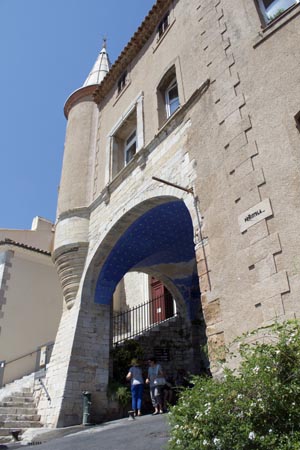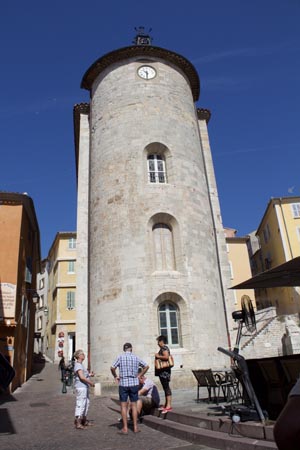 HYÈRES - THE MOST SOUTHERN CITY IN PROVENCE
HYÈRES - THE MOST SOUTHERN CITY IN PROVENCE
CITY OF ART AND HISTORY
Hyères is located about 110 km from Cannes in the Var department in the Provence-Alpes-Côte d'Azur region.
It is the most southern city of Provence, which itself extends along the sea for thirty-nine kilometers.
The peninsula of Giens and the four “golden islands” - Porquerolles, Port-Cros, Levant and Bagaud, are part of the commune known as Hyères.
The islands of Hyères are renowned for the large quantities of lavender found there.
The city of Hyères possesses a rich historical and architectural heritage from the time of antiquity, through the Middle Ages and into the Belle Epoque.
Among the listed historical monuments are the site of Olbia, which dates from the 4th century BC, the oppidum of Costebelle, the castle built between the 11th and 13th centuries, Port Barruc, Portalet Place, Port Massillon, Romanesque house dating from the 13th century, the Collegiate Church of Saint Paul, the Tower of Saint Blaise which dates from the 12th century, the church of Saint Louis from the 13th century, the Villa Tunisienne and the Anatole France school of the 19th century, as well as the Villa Noailles of the 20th century.
The economic life of the city has been closely linked to the salt harvest for centuries: indeed, it was practiced from the time of antiquity through the late 20th century. In the 19th century, the city was transformed into a seaside resort. During the late 1800s, many sumptuous hotels and villas were built. Hyères is labelled as a “city art and history”.
HYÈRES: OLBIA ARCHAEOLOGICAL SITE
Olbia of Provence was founded as a Greek fortress, by Massalia, in the 4th century BC. The colony of Olbiens served to secure the maritime trades. The settler soldiers, the Olbiens, were fishermen and farmers as the same time.
The vestiges of the site present an ancient military city: a thick square rampart flanked by towers, streets with sidewalks and sewers, collective wells, houses, thermal baths and sanctuaries.
The economic activity of Olbia of Provence continued after the defeat of Massalia by Caesar. Centuries later, in 989 AD, the Saint-Pierre Abbey of the Almanarre was built on the remains of the ancient city. In 1220, the Benedictine abbey became Cistercian and existed at that place until the end of the 14th century.
HYÈRES AND HISTORY OF SALT
The name of the city comes from the Latin word Areae which designates the salt marshes.
The wealth of town stemmed from the salt harvest. From antiquity, salt was transported from Hyères throughout Europe.
The Pesquiers salt site has now become an ornithological reserve.
HYÈRES IN THE MEDIEVAL PERIOD
Fief of the lords of Fos, Hyères was the seat of a commandery of the Templars until 1257.
Then the town came into the possession of Charles of Anjou and was attached to the county of Provence.
During the Religious wars, the city of Hyères was dismantled by Louis XIII.
COLLÉGIALE SAINT-PAULE
The Saint-Paul church in the upper town of Hyères has been open to the public since 2016, following the renovation undertaken in 1983.
The first building of the Church of Saint Paul was built in the 12th century in the Provençal Romanesque style. The church became parish in 1221. In 1572, it was redesignated as a collegiate church.
The new gothic-radiant nave was built in the 14th century. This building is placed perpendicular to the old Romanesque church, which became the vestibule, called narthex.
It houses one of the most important collections of ex-voto (i.e., a religious offering given in order to fulfill a vow) in Provence. The collection comes from the Chapel of Our Lady of Consolation which was destroyed in 1944.
 HYÈRES: THE TOWER OF THE KNIGHTS OF TEMPLARS
HYÈRES: THE TOWER OF THE KNIGHTS OF TEMPLARS
From the commandery of the Templars built from the 12th century, to the present day remains the Tour Saint-Blaise.
The tower chapel is located on the ground floor, and the guard room on the first floor.
At the top of the building is the fortified terrace. In the present day, the Tower has become a place reserved for temporary exhibitions of all manner and description.
HYÈRES: ARISTOCRATIC WINTER STATION
King Charles IX and his court stayed in Hyères in 1564.
Thanks to Pauline Borghese, the city became an aristocratic winter resort as early as 1820.
Aristocrats, the bourgeois and the intellectual elite stayed in the great hotels and villas of Hyères. Among them, Queen Victoria, Catherine Medicis, Michelet, Ambroise Thomas, Lamartine, Stevenson, Hugo, Tolstoy, Conrad and many others.
From this period date the Victorian, Moorish or Belle Epoque houses which alongside avant-garde houses such as Villa Noailles.
Among the buildings of the 19th and 20th centuries, three are inscribed on the list of historical monuments: the school Anatole France, Villa Tunisienne and Villa Noailles.
The school known as Anatole France was built during 1888-89. This is an example of the Jules Ferry school of architectural design. The building is endowed with a courtyard of monumental proportions, the decoration refers to the Antiquity.
The Tunisian Villa presents Moorish art with earthenware, bows and geometric motifs. It was the principal residence and the office of Pierre Chapaulart. It was built in 1884 by the architect himself.
The villa Noailles was built in 1920 by Robert Mallet-Stevens. Marie-Laure and Charles de Noailles received in this place all the artistic elite of the Roaring Twenties.
Today, it is a place of creations and exhibitions in the fields of design, architecture, fashion, and photography.
HYÈRES : VINS CÔTES PROVENCE LA LONDE
Les vins d'Hyères bénéficient soit du label IGP (Var, Maures et Méditerranée), soit de l’AOP Côtes de Provence la Londe.
WINE TASTING "CHÂTEAU LES VALENTINES"
Château Valentines offers Provencal wines certified as belonging to the appellation Côte de Provence and Côte de Provence La Londe.
The varied range of wines are marketed as part of a line of gastronomic wines, "Great cuvee No. 8", great gourmet reds, "Caprice of Clementine" and sparkling rosé extra dry wine.
The range of gastronomic wines "Château les Valentines" are typical in character of those commonly associated with the appellation Cotes de Provence.
The "Great cuvee No. 8" family of wines reflect the exceptional characteristics of the land from which they are produced in the best winemaking traditions of the Côtes Provence La Londe appellation. The rosés possess mineral accents, full-bodied and ample. Made from old Ugni-Blanc, Clairette and Vermentine and aged in barrels, the white wines are fine and possess a delicate aromatic balance.
This collection of great gourmet reds offers wines of character, powerful and fine at the same time, with aromas of red and black fruits. Such reds are characterized by spicy cassis-like aromas.
The "Caprice of Clementine" range, for example, possesses flavors of fresh fruits in a delicate and delightful way, giving the rise to exceptional vintages. Rosé wines, on the other hand, are marked by the aromas of fine red fruits and spices. The white wines, in contrast, express the finesse of the Rolle, Clarets, and Ugni-Blanc varietals blended in a manner that provides hints of citrus accompanied by notes of iodine.
Among the wines tasted and described here, two proved especially noteworthy: the white wine "Caprice Clementine" and rosé sparkling wine extra brut. Produced from Ugni-Blanc, Clairette and Vermentine, the white wine is essence of finesse and delicate aromas. The rosé sparkling wine extra brut expresses the fine gourmand notes of citrus, wood strawberries and anise. Elaborated through traditional Provencal methods, this wine possesses fine, light bubbles, and a delightful effervescence.
Address: route de Collobrières, lieu-dit les Jassons, 83250 La Londe-les-Maures



